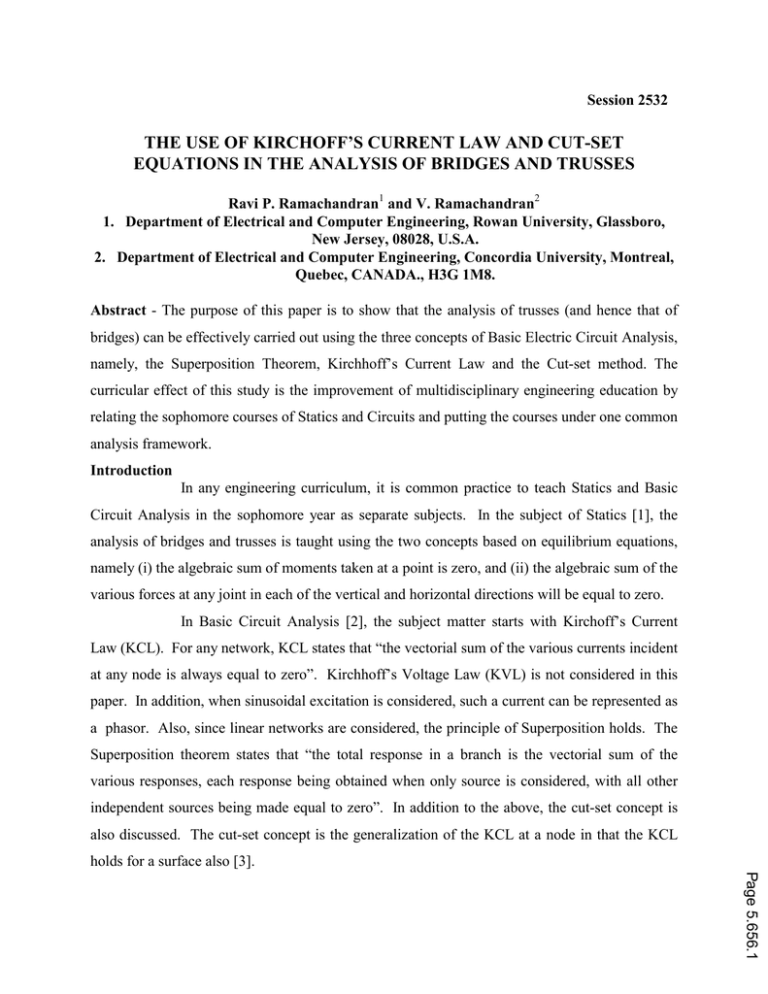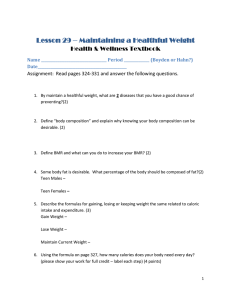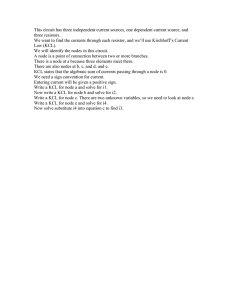The Use Of Kirchoff`s Current Law (Kcl) And Cut Set Equations In
advertisement

Session 2532 THE USE OF KIRCHOFF’S CURRENT LAW AND CUT-SET EQUATIONS IN THE ANALYSIS OF BRIDGES AND TRUSSES Ravi P. Ramachandran1 and V. Ramachandran2 1. Department of Electrical and Computer Engineering, Rowan University, Glassboro, New Jersey, 08028, U.S.A. 2. Department of Electrical and Computer Engineering, Concordia University, Montreal, Quebec, CANADA., H3G 1M8. Abstract - The purpose of this paper is to show that the analysis of trusses (and hence that of bridges) can be effectively carried out using the three concepts of Basic Electric Circuit Analysis, namely, the Superposition Theorem, Kirchhoff’s Current Law and the Cut-set method. The curricular effect of this study is the improvement of multidisciplinary engineering education by relating the sophomore courses of Statics and Circuits and putting the courses under one common analysis framework. Introduction In any engineering curriculum, it is common practice to teach Statics and Basic Circuit Analysis in the sophomore year as separate subjects. In the subject of Statics [1], the analysis of bridges and trusses is taught using the two concepts based on equilibrium equations, namely (i) the algebraic sum of moments taken at a point is zero, and (ii) the algebraic sum of the various forces at any joint in each of the vertical and horizontal directions will be equal to zero. In Basic Circuit Analysis [2], the subject matter starts with Kirchoff’s Current Law (KCL). For any network, KCL states that “the vectorial sum of the various currents incident at any node is always equal to zero”. Kirchhoff’s Voltage Law (KVL) is not considered in this paper. In addition, when sinusoidal excitation is considered, such a current can be represented as a phasor. Also, since linear networks are considered, the principle of Superposition holds. The Superposition theorem states that “the total response in a branch is the vectorial sum of the various responses, each response being obtained when only source is considered, with all other independent sources being made equal to zero”. In addition to the above, the cut-set concept is also discussed. The cut-set concept is the generalization of the KCL at a node in that the KCL holds for a surface also [3]. Page 5.656.1 It is the purpose of this paper to show that the above-mentioned concepts of basic circuit analysis can be effectively used in the analysis of bridges and trusses. This common framework in the analysis of structures and circuits should be shown to the students to provide a better comprehension of the relationship between the two subjects of Statics and Circuits. For purposes of illustration, the example in [1, pp.284] will be considered in this paper with the difference that the length of each arm is arbitrary and the forces acting at junctions are independent of one another. This is as shown in Figure1. f1 A d6 d1 θ1 θ5 f2 B θ4 D d3 d2 θ3 θ2 C E d5 d4 Figure 1 A general truss considered for illustration purposes. Superposition Theorem The general analysis requires that the moment about C is taken first. This gives f1(d1 + d2) + f2d2 - E.d5 = 0. (1) The objective is to determine the vertical component E. It is readily made up of two parts E1 (due to f1) and E2 (due to f2). By making f2 = 0, we get E1 = f1 (d 1 + d 2 ) d5 (2) By making f1 = 0, we get E2 = f2 d 2 d5 (3) Thus, E = E1 + E 2 = f 1 (d1 + d 2 ) + f 2 d 2 d5 (4) This concept can be readily extended for any number of forces present. This permits us to determine the contribution of each force to E. The above discussion makes it clear that the principle of superposition (which is the starting point and the basis for linear system theory [4]) can be readily applied here. This Page 5.656.2 means that one force at a time can be considered, making all other forces equal to zero. This will enable one to determine the contribution of each force to the reactions at the hinged ends by the equilibrium equation. In addition, the concept of scaling can be also be applied in that first, a unit force is applied and its effect can be determined. Then, the required multiplication factor is applied to obtain the actual effect. This can be illustrated as follows: Let f2 = 0 and a unit force be applied at the junction A. Then, from (2), we get E 1a = (d 1 + d2 ) d5 (5) When a force f1 is applied, this is multiplied by a factor f1 so that f1 (d 1 + d 2 ) d5 E 1 = f1 .E 1a = (6) The factor E1a is the influence coefficient. The effect of f2 can be obtained in a similar fashion. Kirchhoff’s Current Law (KCL) In order to illustrate this principle, we choose one suitable junction for the purposes of analysis. In this case, we start with the junction A, which in circuit theory terms, is a node. The corresponding force diagram, depicting both external and internal forces, is shown in Figure 2. FAD d a = d 23 + d 26 d6 f1 FAB d3 Figure 2 The force diagram for the junction A. Analysis of the force diagram yields the equilibrium equation, FAD 2 3 d +d 2 6 = FAB f1 = d3 d6 (7) from which FAB and FAD are determined given f1. To use KCL, we make use of a fundamental system modeling concept that states that a force and current are analogous through variables [4][5]. This enforces the fact that the concept of the vectorial sum of forces at a joint being zero is the application of KCL to a Page 5.656.3 structure. Continuing with the example, we construct a vector phasor diagram which is identical to the shape of the truss at junction A. This is as shown in Figure 3. f1 FAB θ1 FAD Figure 3 The vector or phasor diagram corresponding to junction A. This diagram is made up of the various forces in each arm incident at the junction A. The forces in each arm are represented by an appropriate complex quantity. The horizontal axis becomes the real axis and the vertical axis becomes the imaginary axis. The directions of FAB and FAD can be chosen in an arbitrary manner initially. Application of KCL at node A gives - jf 1 + FAB + FAD e -jθ1 = 0 (8) where j is a complex number (j2 = -1). While writing Equation (8), the force (or equivalently, current) entering the junction (or equivalently, node) is taken to be negative and the force leaving the junction is taken to be positive. Equating the real parts, we get FAB + FAD cos(θ1) = 0 (10) Since cos(θ1 ) = d3 2 3 d + d 26 , (10a) we get FAD d 32 + d 62 =− FAB d3 (10b) Equation (10b) shows that the direction of one of the forces, namely either FAB or FAD has to be reversed. Equating the imaginary parts, we get -jf1 - j FAD sin(θ1) = 0 (11a) Since sin(θ1 ) = d6 d 23 + d 26 , (11b) we get Page 5.656.4 FAD 2 3 d +d =− 2 6 f1 d6 (12) This clearly shows that the direction of FAD has to be reversed, because the direction of f1 is already given. The combination of Equations (10b) and (12) gives Equation (7). This demonstrates clearly that KCL can be effectively used in the analysis. It is noted that this analysis gives both the magnitude and the direction of the force in each arm. It is readily seen that the horizontal component of the force is given by the real part and the vertical component of the force is given by the imaginary part. Cut-set Equations It is known that every node is a cut-set, in that the cut-set divides the network graph into two distinct parts [3]. Some of the cut-sets (dotted lines) are shown in Figure 4. f1 C1 C3 A f2 C B C2 D E Figure 4 Some cut-sets in the graph depicting the truss. The equation corresponding to node A is given in Equation (8). This also gives the equation corresponding to the cut-set C1. A similar equation can be written corresponding to node D, which is as follows: − FAD e jθ1 + FDE + FDB e jθ4 = 0 (13) Equation (13) is also the cut-set equation corresponding to C2. Equations (8) and (13) give the various forces along the branches AD, DE, AB and DB. Also, addition of (8) and (13) yields - jf1 + FAB + FDB e jθ4 + FDE = 0 (14) This is the equation corresponding to the cut-set C3. Equation (14) can either be used to verify the various forces already determined or used in the analysis to determine the forces. As an illustration, equating the imaginary parts in (14), we get FDB sin(θ4) = f1 (15) Since Page 5.656.5 sin(θ4 ) = d6 d 26 + (d 1 - d 3 ) 2 , (16) we get FDB = f1 . d 62 + (d 1 - d 3 ) 2 d6 (17) This suffices to prove that the cut-set equations can be used effectively in the analysis. More cutsets can be used. In fact, Cut-set analysis gives the same equations as the Method of Sections. These two methods are hence, analogous. Similar analysis can be carried out for other nodes, thereby completely determining the various forces and their respective directions in all the branches. Conclusions The foregoing discussion clearly shows that the three concepts of basic circuit analysis, namely Superposition, KCL and Cut-set analysis can be effectively used in the analysis of trusses. Thus, this paper makes a thrust at multidisciplinary engineering education by showing the equivalence of structures and circuits thereby depicting the isomorphism in the analysis techniques. It is suggested that courses on Statics and Circuits can be improved and looked at under one common analysis framework. References 1. F. P. Beer and E. R. Johnston, Jr., “Vector Mechanics for Engineers: Statics”, McGraw- Hill Book Co., 1996. 2. J. W. Nilsson and S. A. Riedel, “Electric Circuits”, Addison -Wesley Book Co., 1996. 3. N. Balabanian and T. Bickart, “Linear Network Theory: Analysis, Properties”, Matrix Publishers, 1981. 4. R. C. Dorf and R. H. Bishop, “Modern Control Systems”, Addison-Wesley Book Co., 1998. 5. J. F. Lindsay and V. Ramachandran, “Modeling and Analysis of Linear Physical Systems”, Weber Systems Inc., January 1991. Acknowledgement The authors thank Dr. Rama Bhat for helpful discussions during the preparation of the paper. Page 5.656.6 Biography Ravi P. Ramachandran is an Associate Professor in the Department of Electrical and Computer Engineering at Rowan University. He received his Ph.D. from McGill University in 1990 and has worked at AT&T Bell Laboratories and Rutgers University prior to joining Rowan. V. Ramachandran is a Professor in the Department of Electrical and Computer Engineering at Concordia University. He received his Ph.D. from the Indian Institute of Science in 1965 and was on the faculty at the Technical University of Nova Scotia prior to joining Concordia. Page 5.656.7 Biography


